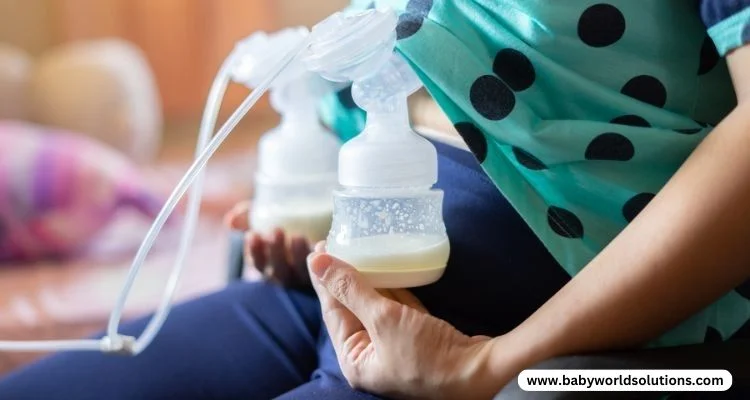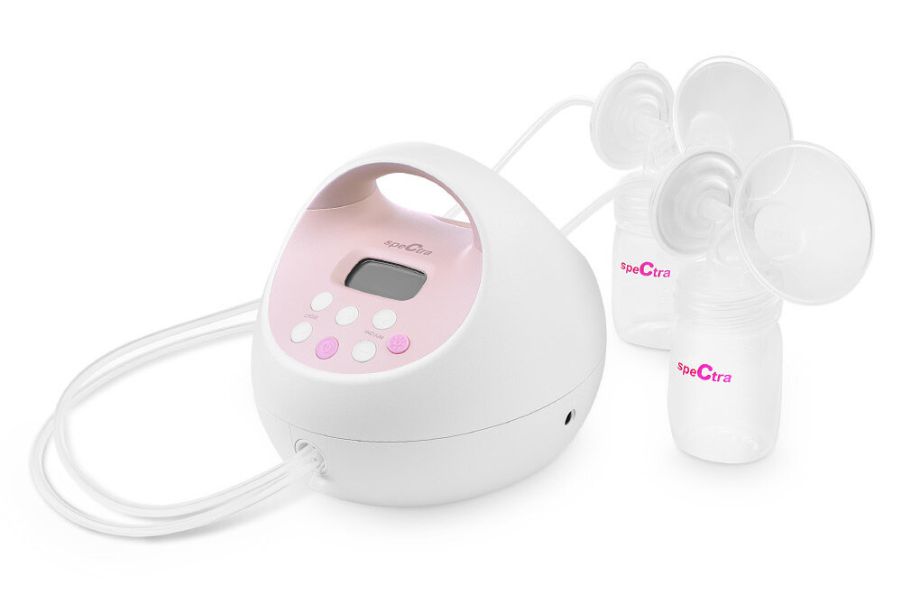As a new pumping mom, you may struggle to balance motherhood’s responsibilities with other aspects of your life, such as your career or hobbies.
While breastfeeding offers a great means of nourishing your baby, it can also be challenging when you are away from your little one for a longer time, such as at work, shopping, or doing house chores.
Related: How to Combine Breastfeeding and Pumping?
15 breast pumping tips for new moms
Breast pumping is essential for breastfeeding moms to ensure that their little ones still receive the proper nutrients even when moms are not around. However, breast pumping can be confusing for new pumping moms, so I’ve compiled some breast pumping tips for new moms, which I gathered from my motherhood journey to simplify the process.
Find the right pump for you.
The first step is to find the right breast pump for successful pumping. Consider your lifestyle and how often you must be away from your baby. Remember, a manual pump is more suitable for infrequent use, while an electric breast pump may be more practical for mothers who frequently express milk.
To determine the most suitable pump, thoroughly research the available options. Here’s a brief overview of the different types:
- Single-Electric: Ideal if you plan to supplement breast milk.
- Double-Electric: The optimal choice for mothers who return to work or spend significant time away from their babies daily.
- Double-Electric Hands-Free: Now, hands-free options fit inside your bra. They are often pricier and may not be covered by insurance, but it is an excellent option if it fits your budget.
- Manual Pump: A manual pump works well if you only pump occasionally. We also recommend having a manual pump as a backup to an electric pump, just in case.
Read your pump manual.
Once you have chosen the appropriate pump per your requirements, it is crucial to carefully peruse the manual to be aware of its operation and maintenance.
Before utilizing the pump, please ensure that you are familiar with each component and its interplay.
Find the correct flange size.
Flanges, also known as breast shields, come in different sizes. Most breast pump manufacturers provide flange sizing kits so you can measure your nipple size. For best results, select the correct size; if your nipples are too small for the flanges, you may experience discomfort while expressing.
Choose a comfortable pumping position.
Breastfeeding can be uncomfortable enough, so it is essential to be comfortable when pumping your breast milk. Like me, many women prefer the classic sitting position. You could also pump while lying down, standing up, or in a rocking chair.
What is the best position to pump breast milk?
The best position is upright when you are ready to pump your breast milk. You can sit in a comfortable chair or stand up with your back supported. Make sure you have a flat surface to place your pump on.
You must be comfortable and relaxed while pumping, so take the time to get in your best position. Use pillows or cushions to support your arms and back, and keep your feet on the floor or a footstool.
You may also want to place a warm cloth on your breasts to help stimulate milk production. Pumping in the same position each time will help you become more comfortable and productive.

How to sit when pumping breast milk?
The best way to sit when pumping breast milk is in a comfortable and relaxed position. You may sit in an armchair, recliner, or straight-backed chair – whichever you find most comfortable and supportive.
Place your feet flat on the floor and use pillows or cushions to support your back, arms, and neck. Make sure your pump is placed on a flat and stable surface. Use a warm cloth or hot compress on your breasts for a few minutes before you start pumping to help stimulate milk production. Taking the time to find the best position for you will make pumping more comfortable and efficient.
Maintain good hygiene
Ensuring that all your pump parts are clean and sanitized is a priority when pumping. Always wash your hands before and after expressing or handling milk, and clean all pump parts in hot, soapy water between each use.
Take breaks
Breaks are essential for both you and your baby during a pumping session. When taking a break from the pump, gently massage your breasts or hand express some milk to increase your milk production.
Eat and drink enough.
It is essential to stay hydrated and well-nourished while pumping. Make sure you eat healthy meals and keep a glass of water nearby during pumping sessions.
Read Also: Why Does My Breast Milk Look Watery– 7 Possible Reasons
Find a comfortable pumping bra.
Having a hands-free pumping bra will make it much easier to pump. Look for bras with adjustable straps, support, and slots in which your flanges can fit.
Choose a pumping schedule that works for you.
Finding a pumping and breastfeeding schedule that works for you and your baby can be challenging. Consider the frequency of feedings when establishing your pumping routine; if your baby feeds every three hours, try to pump between feedings.
Moreover, scheduling regular pumping sessions will help to establish and maintain your milk supply. You may want to pump around the exact times each day, or you can adjust your schedule based on how often you need to be away from your baby.
Pumping and storing breastmilk
Once your pumping session ends, you must store the milk. Be sure to follow the appropriate guidelines when storing breastmilk; refrigerated milk should be used within 24-48 hours, while frozen milk can last up to three months in a freezer.
Read Also: How Long Does Breast Milk Last After Warming?
Pump both breasts simultaneously.
You can reduce the time spent on each session when pumping both breasts simultaneously. Ensure comfort when pumping both breasts at once by using a hands-free bra or adjusting the flanges to the correct size.
Massage breast before starting
Massaging your breasts can help to stimulate more milk production. Before starting the pump, try to massage each breast for a few minutes in circular motions.
Be patient
Don’t lose heart if you don’t witness immediate outcomes during breast pumping, as it can be time-consuming. The augmentation of breast milk production necessitates patience and a steadfast approach, so it is imperative to maintain consistency.
Establish a comfortable environment.
Breast pumping should be a relaxing experience, so ensure your environment is comfortable. Find a quiet space with minimal distractions and place yourself in an upright position with plenty of support. You may also want to listen to soothing music or watch a favorite show while pumping to help you relax.
Get some help
If you are having difficulty establishing and maintaining your milk supply, seek the advice of a lactation consultant who can offer personalized tips. Additionally, don’t hesitate to enlist help from family or friends if you need extra support.
When to pump breast milk? Pumping every 4 hours instead of 3?
If your baby does not take bottle feedings, pumping is essential. Every mother is unique, and there is no one-size-fits-all approach to pumping. For some mothers, pumping every 4 hours instead of 3 may be the most successful option.
When is the best time to pump? It might include pumping once during each day’s meals and in the middle of the night. However, Many breastfeeding experts suggest the best time of day to pump is in the morning when the milk supply tends to be higher. This is typically when breasts are fuller, and milk production is at its peak.
Some mothers pump more frequently (every two or three hours) to maintain an adequate milk supply while allowing the mother to sleep a whole night. If you’re co-nursing, you can also time your pumping sessions with your baby’s nursing schedule.
If you go back to work, it is important to establish a pumping schedule that mimics your baby’s feeding schedule as closely as possible. It will help to maintain your milk supply in the long run. You can also consider supplementing with formula between pumping sessions if necessary.
Remember that your body will respond better to a consistent routine regarding pumping. You may find that you produce more milk when you pump simultaneously daily and at night, so stick to a schedule as much as possible.
Finally, take breaks from pumping to allow your body time to rest and rebuild its milk supply. Taking breaks can also help prevent engorgement and other related issues.
- It’s best to pump when your breasts feel full, firm, and heavy. This feeling usually occurs every 1.5 – 2 hours during the day or 8 – 10 times in 24 hours.
- If you are sleep-deprived, setting the alarm a few minutes earlier than your usual time to pump may be more accessible.
- You must maintain a regular pumping schedule. If you are an exclusively pumping mother, you mur 8 – 10 times each day (including at least once in the middle of the night), with sessions lasting 15 – 20 minutes each time.
How to Pump- breast pumping tips get more milk.
- Find a comfortable and private place to pump.
- Ensure you are relaxed and keep your mind occupied with something else, such as music, podcasts, or reading.
- When pumping, use a hands-free flange system to move around if needed.
- To help prevent clogged milk ducts, massage your breast while pumping or use a warm compress before and after sessions.
- If one side produces more milk than the other, switch sides frequently throughout each session.
- It’s important to remember that it can take some time to get into a good rhythm and produce the amount of milk you need. Be patient and keep at it!
- Lastly, empty your breast before switching sides so that neither is overworked. It will help promote a good milk supply and ensure no milk goes to waste.
How long to pump first week?
The length of time to pump will vary depending on the individual. When you start pumping for the first time, increasing the amount of milk, you pump gradually is recommended. To begin with, aim to pump for 10-15 minutes per session twice a day.
As you acclimate to the revised pumping routine and grow more at ease, you can progressively extend the duration of each session. Additionally, monitoring the length of time you spend pumping and paying attention to any indications of breast fatigue or discomfort is essential.
If either of these issues arises, pausing and taking a break before resuming is advisable. Moreover, it is crucial to remember that the quantity of milk expressed during the initial week is expected to be lower than your usual output. However, as your body adapts, its milk production capacity will gradually increase.
Consistent and frequent pumping will help you reach this higher production level sooner. Additionally, get plenty of rest and drink lots of water to keep your body and milk supply healthy.

Do’s and Don’ts of pumping
Do’s:
- Use a hands-free flange system or other breastfeeding accessories to make pumping more comfortable and efficient.
- Try to create a regular schedule for your pumping sessions, aiming for 8 – 10 times each day (including at least once in the middle of the night).
- Massage your breasts while pumping or use a warm compress before and after sessions to help prevent clogged milk ducts.
- Switch sides frequently throughout each session, and empty the breast before switching.
- If you’re feeling overwhelmed, take breaks from pumping to allow your body time to rest and rebuild its milk supply.
Don’ts:
- Do not go too long between pumps, as this can decrease your milk supply.
- Avoid going over 20 minutes per pumping session, which can cause discomfort or pain.
- Make sure to skip pumping sessions to create a consistent milk supply.
- Avoid pumping in public places where you may feel uncomfortable or exposed.
- Do not use your pump as a pacifier for your baby, as this will confuse their natural feeding cues and may cause them to refuse the breast later on.
- Lastly, be easy on yourself if you need help with your pumping schedule. With practice and consistency, you can find success!
Pumping breast milk can be a challenging experience, but it can also be gratifying. With the proper knowledge and exclusive pumping tips, you can create a successful pumping routine that works best for you and your baby.
How long can I go without pumping?
It depends on your situation as a breastfeeding mother. However, how long can you go without pumping? Suppose you are breastfeeding exclusively (i.e., without supplementing with formula). In that case, you should pump at least eight times in 24 hours to maintain your milk supply and ensure your baby gets enough nutrition.
If you plan on being away from the baby for more than 3-4 hours, it’s best to pump so your body can continue producing enough milk. If you supplement with formula, pumping less frequently may be an option depending on the amount of formula supplementation and your supply.
What happens if you don’t pump for 8 hours?
If a pumping mom doesn’t pump for 8 hours, it can lead to engorgement, where your breasts become excessively full and uncomfortable. Moreover, you can also feel pain, swelling, and difficulty latching while breastfeeding. It may also decrease your milk supply and lead to clogged ducts or mastitis. Regular and timely pumping helps maintain milk production and prevents these issues.
Pumping tips for large breasts?
- Wear a supportive bra: A good-fitting bra is essential for those with large breasts. Look for bras designed to provide extra support and lift without squeezing or constricting. Choose styles with wide, adjustable straps and full-coverage cups.
- Consider investing in a compression vest: A compression vest can help reduce the strain put on your neck, shoulders, and back from large breasts by providing additional support. Look for vests made of breathable, lightweight materials and adjustable straps for a secure fit.
- Try breast massage techniques: Breast massage can help to reduce the discomfort associated with large breasts by releasing tension in the chest muscles and improving circulation. Use light, circular motions to gently massage your breasts, starting from the outside and gradually moving inward towards the nipples.
- Exercise: Regular exercise can help reduce the strain that large breasts put on the rest of your body. Incorporate whole-body activities like walking, running, and swimming into your weekly routine to improve strength and posture.
- Seek medical advice if necessary: If you’re still experiencing discomfort or difficulty due to your large breasts, it might be time to consult a medical expert. Your doctor can provide additional tips and advice on reducing the strain of having large breasts.
No matter your size, taking good care of your breasts and ensuring you have the proper support is essential. With the right tools, tips, and techniques, you can minimize discomfort from having large breasts and maintain a healthy lifestyle.
Final Words: Breast pumping tips for new moms
Breastfeeding is an incredible gift for both mothers and their babies, but it can be challenging for new moms who need to be away from their little ones for extended periods. With the right breast pump and a little help, you can ensure your baby still receives all the nutrition they need even when mom is away. So take a deep breath, relax, and enjoy the journey of motherhood!
Pumps also come in various sizes, and choosing one that fits your breast correctly is essential to avoid discomfort and improper milk extraction. Once you’ve selected your breast pump, it’s necessary to establish a consistent pumping schedule. The pumping frequency depends on your baby’s age, feeding schedule, and if you are returning to work. It also helps to burn calories.
Generally, it’s recommended to pump every three hours or as often as you would nurse your baby if you were present. Pumping regularly alerts your body to produce milk, ensuring a steady supply and preventing engorgement or infection.
Proper breast pump hygiene is also essential, as it protects you and your baby from illness. Wash your hands before handling the equipment and clean all parts of the breast pump after every use, following the specific pump instructions.
And, if any parts of your pump or accessories that touch your skin break or crack, replace them immediately. Breast pumping can be time-consuming, so making the process as comfortable as possible is essential. Have a comfy chair and a glass of water nearby while pumping. You can read, watch TV, listen to music, or chat with your significant other to take your mind off the process.
Lastly, feel free to seek professional help or support. Lactation consultants can help with any questions or provide additional resources. Support groups or connecting with other breastfeeding moms can also offer emotional encouragement. Breastfeeding and pumping can be overwhelming and stressful, so never hesitate to seek help.
Parents Also Ask
How long does it take to pump breast milk for the first time?
For many mothers, seeing results can take a few days or weeks. The milk produced will increase over time as the body responds to pumping stimulation.
What are the side effects of pumping breast milk?
Some common side effects of pumping breast milk exclusively include:
Sore nipples
Engorgement of the breasts
Low milk supply.
1 Visit today





